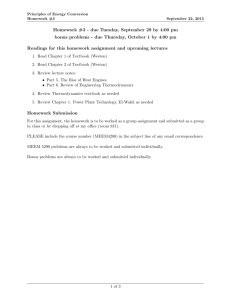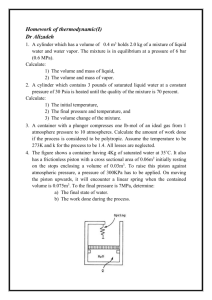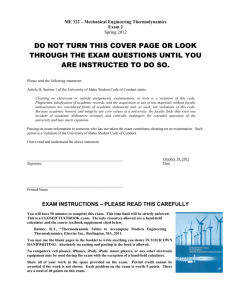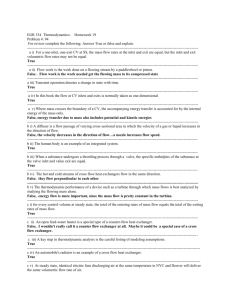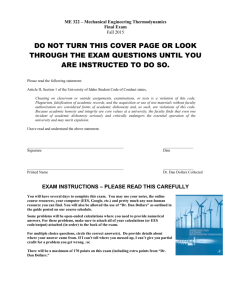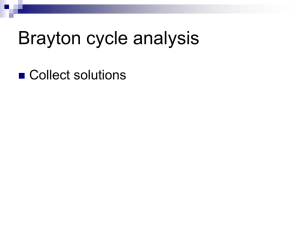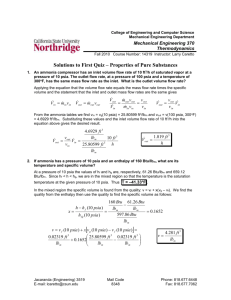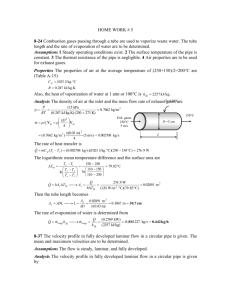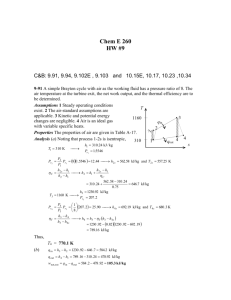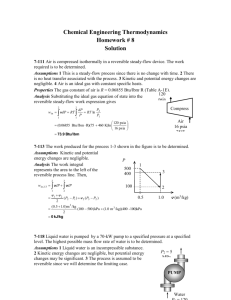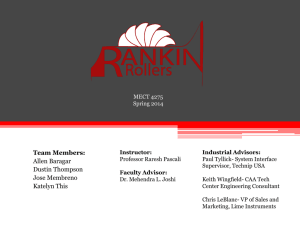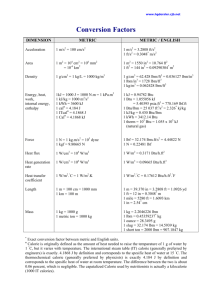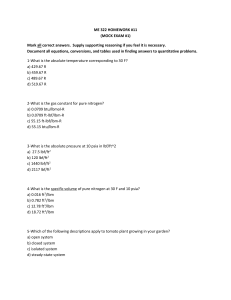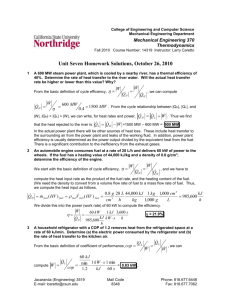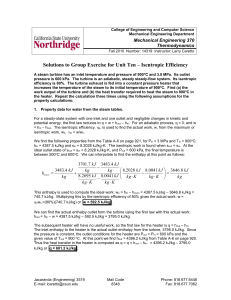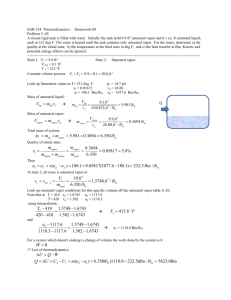Take-Home Exam - University of Idaho
advertisement
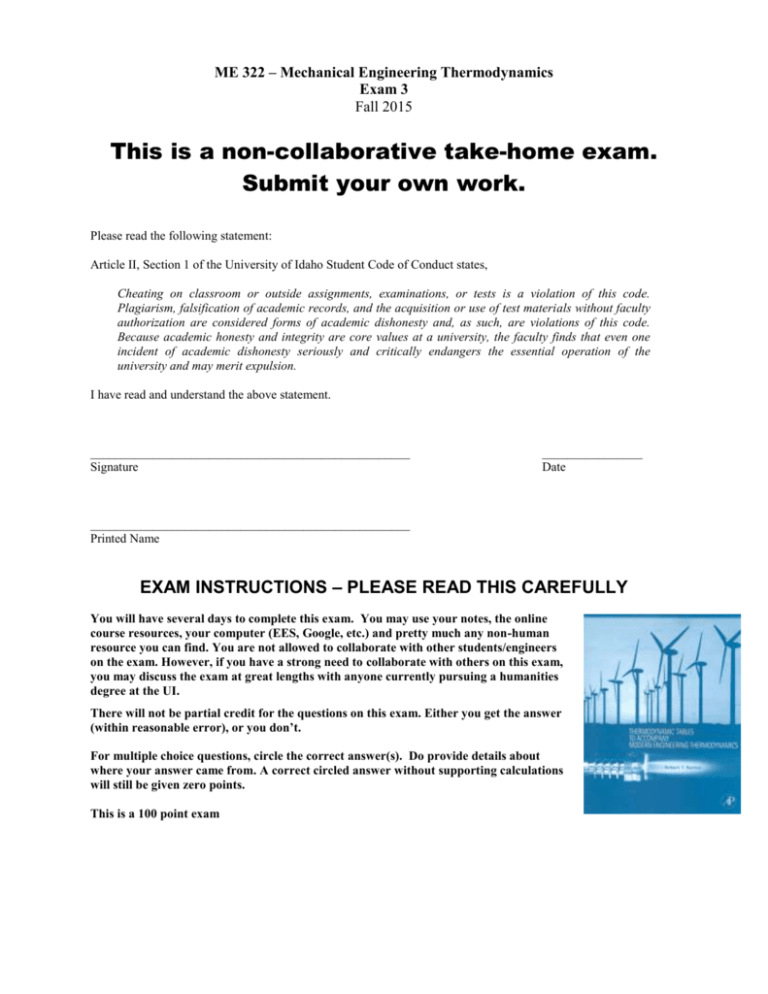
ME 322 – Mechanical Engineering Thermodynamics Exam 3 Fall 2015 This is a non-collaborative take-home exam. Submit your own work. Please read the following statement: Article II, Section 1 of the University of Idaho Student Code of Conduct states, Cheating on classroom or outside assignments, examinations, or tests is a violation of this code. Plagiarism, falsification of academic records, and the acquisition or use of test materials without faculty authorization are considered forms of academic dishonesty and, as such, are violations of this code. Because academic honesty and integrity are core values at a university, the faculty finds that even one incident of academic dishonesty seriously and critically endangers the essential operation of the university and may merit expulsion. I have read and understand the above statement. ___________________________________________________ Signature ________________ Date ___________________________________________________ Printed Name EXAM INSTRUCTIONS – PLEASE READ THIS CAREFULLY You will have several days to complete this exam. You may use your notes, the online course resources, your computer (EES, Google, etc.) and pretty much any non-human resource you can find. You are not allowed to collaborate with other students/engineers on the exam. However, if you have a strong need to collaborate with others on this exam, you may discuss the exam at great lengths with anyone currently pursuing a humanities degree at the UI. There will not be partial credit for the questions on this exam. Either you get the answer (within reasonable error), or you don’t. For multiple choice questions, circle the correct answer(s). Do provide details about where your answer came from. A correct circled answer without supporting calculations will still be given zero points. This is a 100 point exam Part 1: Engineering Calculations – each numbered problem is worth 10 points Write your answers in the space below Attach your EES code and output to the back of the exam Problems 1-3 apply to the following description and diagram. A steam power cycle that incorporates one reheat leg is shown in the sketch below. Steam from the boiler enters the high pressure turbine at 1850 psia, 1400°F. The steam leaves the high pressure turbine at P[2] and then enters the reheat section of the boiler where it is reheated back to 1200°F with no pressure drop. The steam then enters the low pressure turbine where it expands to 10 psia. Enough heat exchange area is provided in the condenser such that the water leaving the condenser is saturated liquid at 10 psia. Both the high and low pressure turbines have an isentropic efficiency of 85% and the pump has an isentropic efficiency of 95%. The net power output of the cycle is 400,000 hp. 1) To maximize thermal efficiency of the cycle, at what P[2] (in psia) should the steam be taken back to the boiler for reheat? (Hint: Conduct a parametric study to figure out the optimal value of P[2]). 2) At the optimal value for P[2], what is the value of Q_dot_in (in Btu/hr)? Remember, this should include both the initial heating, and the reheat loop. 3) Assuming you have a high temperature reservoir at 1800 °F, and a cold temperature reservoir at 200 °F, calculate the maximum theoretical efficiency (think Carnot) of this system? 4) A particular steam turbine can handle a maximum of 1500°F at the inlet. The exhaust pressure is 12 psia. Under ideal (isentropic) conditions, the maximum allowable liquid in the turbine is 10%. Use EES to calculate: a. Under real conditions, when the turbine is not isentropic, find the maximum isentropic efficiency (in %) that would still ensure that no liquid water was in the turbine. b. Comment on the likelihood of there ever being liquid water in the actual turbine. 5) 5 lbm/second of saturated mercury vapor flows in to a valve. The mercury enters at 400 psia, and leaves at 10 psia. Find the following: a. The quality of the mercury exiting the valve b. The entropy production rate, assuming valve is adiabatic (in Btu/sec-F) 6) Using the same input as the problem above, if you were to replace the valve with an ideal turbine (isentropic), and have the mercury exit with a quality of 0, calculate the following: a. How much heat will be transferred out of the turbine (Btu/sec)? b. How much power power could be generated by the turbine (Btu/sec)? 7) A house is using a heat pump with an earth-coupled isothermal source as an energy source. The heat pump uses R134a as the working fluid. At the depth of the heat source the earth’s temperature can be assumed to be constant year-round. This results in a year-round standard evaporating temperature of 55°F. Thermal energy from the condenser is available at 75 F. The compressor has an isentropic efficiency of 80%. Assume pressure drops through plumbing are negligible. The refrigerant leaves the condenser with 8 degrees of subcooling and it enters the compressor with 15 degrees of superheat. Under these conditions, the heat pump delivers 65,000 Btu/hr to the house. Calculate the following: a. The power requirement (hp) of the compressor b. The mass flow of R134a (lbm/hr) c. Coefficient of performance for heating 8) In lecture 32 we did an example calculating the work required in a compressor for a mixture of methane and ethane. Repeat this problem, but instead of the methane/ethane mixture, use air. In particular, use the composition of air as given in the beginning of Example 12.2 in your textbook. Your EES code should be set up to be as adaptable as possible (for other mixture compositions), and will probably have lines like: f$[1..4] = ['N2', 'O2', 'Ar', 'CO2'] y[1] = .7809 y[2] = .2095 y[3] = .0093 y[4] = .0003 y_total = SUM(y[k], k=1, 4) Given: A compressor is being used to move a mixture of air. The mixture enters the compressor at 20 psia, 70°F and leaves the compressor at 80 psia. The compressor is being modeled as isentropic. P2 80 psia wc 1 P1 20 psia T1 70F Calculate the following: a. Work required (Btu/lbm) to the compressor using air composition from Example 12.2 b. Work required (Btu/lbm) to the compressor using ‘air_ha’ as your fluid in EES Part 2: Short Calculations – each problem worth 5 points 9) You have a 100 W halogen light bulb, and a 100 W LED light bulb. Assume that both produce the same quantity of light. Under steady-state conditions, the halogen bulb operates at 1000 °C, and the LED bulb operates at 30°C. Calculate the steady-state entropy production of each. Comment on which one you would choose, and why. 10) What is the mass fraction of oxygen in a mixture that has equal volumes of oxygen (O2) and carbon dioxide (CO2)? Part 3: Multiple Choice – each problem worth 2.5 points Some problems may have multiple answers Problems 11-14 apply to a vapor compression refrigeration cycle that utilizes ammonia as the refrigerant. The saturated evaporating temperature is -10 F and the saturated condensing temperature is 95 F. Saturated vapor exits the evaporator and saturated liquid exits the condenser with no subcooling. The mass flow rate of the refrigerant in the cycle is 300 lbm/hr. 11) What is the enthalpy of the fluid entering the evaporator? a) 32.1 Btu/lbm b) 149.4 Btu/lbm c) 608.5 Btu/lbm d) 632.6 Btu/lbm 12) What is the enthalpy of fluid exiting the evaporator? a) 32.1 Btu/lbm b) 149.4 Btu/lbm c) 608.5 Btu/lbm d) 632.6 Btu/lbm 13) What is the refrigeration capacity of this system (in tons)? a) 5.5 tons b) 7.5 tons c) 9.5 tons d) 11.5 tons 14) What is the DSC for this cycle? a) -10 F b) 0 F c) 10 F d) 95 F Feel free to draw a picture of the cycle down below. A P-h diagram could be useful.
